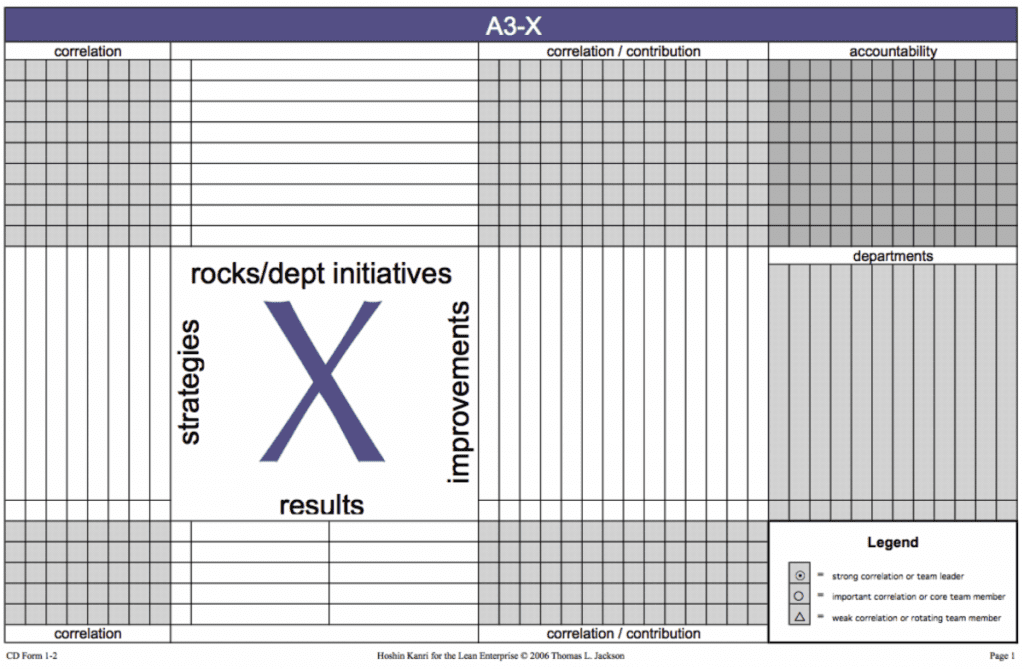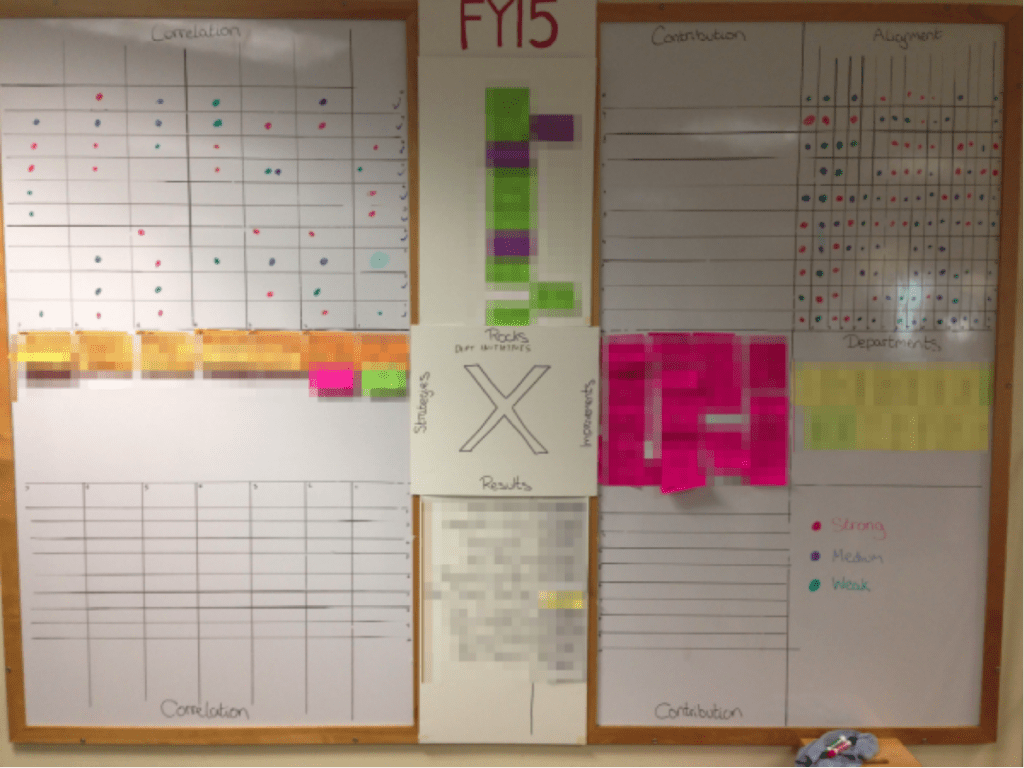This post was originally published on the Rally Blog and I am reposting here to keep an archived copy. It was part of a series in which we described various aspects of the way the business was run. Apart from one minor edit to help it make sense as a stand alone piece I have left the content as it was. However, I suspect that since Rally is now part of CA Technologies, much of what I described has changed.
Rally has a regular, quarterly cadence with which we manage corporate planning, and in which we invest heavy preparation so that we get maximum value. For this year’s Annual Planning, preparation included creating market and opportunity maps and a set of potential strategies, as well as crafting an agenda to help facilitate the collaborative co-creation of the outcomes.
What is Annual Planning?
At Rally, Annual Planning is a two-day meeting involving around 80 people – roughly 70 Rally employees and 10 invited customer representatives. The employees are a mix of people representing all areas of the business: directors and above always attend these key corporate cadences, and other members of the company take turns participating. The customers chosen to join us are those who have shown a keen interest in seeing how we facilitate these large events, and from whom we can learn and get great feedback. Apart from the confidential opening introduction, the customers are involved throughout: spread out across business groups and breakouts, sitting amongst employees, and actively working and contributing as much as anyone else.
This year, we ran Annual Planning a quarter in advance of the financial year we’re about to start. We’ve learned that the initial plan will need validation and refinement, and thus we need to allow time for that to happen. Therefore, the purpose of the two days was to draft our corporate plan for the next financial year, so that we can validate it in the final quarter of the current financial year.
What Do We Do in Annual Planning?
Over the years, we have settled on terminology for corporate planning, inspired by a couple of books. First, Pascal Dennis’ Getting the Right Things Done introduces the terms “True North” and “Mother Strategies.” The True North is the single mantra or slogan that defines where the company wants to be at the end of the year. Mother Strategies are the focus areas that will help us arrive at the True North.
The True North and Mother Strategies guide the day-to-day departmental work, along with cross-departmental initiatives, which are known as “Rocks.” Rocks are inspired by techniques described in Verne Harnish’s book, Mastering the Rockefeller Habits. The metaphor of a Rock is based on the idea that if you have a bucket, you should fill it first with a few big rocks: these are the big things you want to accomplish. If there is more space you can then put in pebbles, or medium-sized projects. With any remaining space you can put in sand, or the tactical tasks. Finally, you can add water — the ad-hoc things that arise. If you fail to put the big rocks in first, you will inevitably fill your bucket with just sand and water.
For Rally, the annual plan, therefore, consists of a True North, a number of Mother Strategies, and a set of Rocks. In addition, this year we introduced a new tool to help create transparency and align all the elements: the X-matrix, as described in Thomas L. Jackson’s Hoshin Kanri for the Lean Enterprise. This brought with it a further level of discipline by including the business results we’re targeting, and the measurable improvements we will use to track progress.
As you can see from the blank template above, completing the X-matrix involves deciding on strategic goals, tactical rocks (and other departmental initiatives), measurable improvements, and business results. These are entered into the large white sections alongside each section. In addition, filling in the shaded corner cells of the X-matrix indicates the correlation or contribution between each of these elements, as well as how accountable each department will be for the tactical work. The strength of the correlation or accountability is indicated with one of three symbols according to the legend: strong correlation or team leader, important correlation or team member, and weak correlation or rotating team member. An empty cell indicates no correlation or no team member.
How Does It Work?
The agenda for the two days of Annual Planning involved exploring and defining all these pieces of the puzzle, ultimately filling in a giant X-matrix created on a wall. The picture below shows this partially completed. Taking the advice from the book, we adapted rather than adopted the technique, changing some of the terminology to better fit our context.
Here’s what each day looked like.
Day one was focused on divergence: generating a range of ideas which could go into the initial draft of the plan. We began with a retrospective on the current year; working individually, in pairs, and then in departments, we reflected on what we’d learned that would guide our work in closing out this year and setting us up for next year. Then, the executive team gave a readout of their perspectives and introduced the proposed potential strategies for next year. This led into an Open Space with breakout sessions focused on exploration of rocks and improvements that could implement those strategies. As a result, by the end of the first day we had a good understanding of the current situation, with a variety of potential work that might be needed to meet our goals.
Day two was focused on convergence: refining all the ideas and getting consensus on a plan that could be validated. Groups initially formed around the proposed strategies to look at the plan through a “strategic lens.” Each group discussed how various rocks and improvements aligned to their strategy, and agreed on a proposal that they wanted to make for inclusion in the plan.
In a high-energy session, the proposals were pitched to three of the executives, who accepted them (with a chime) or rejected them (with a horn). Rejected proposals were updated and re-pitched, until we ended up with the X-matrix containing the top 10 rocks and associated improvement measures, along with the strength of the correlation between all the rocks and strategies. Groups then re-formed around departments to look at the plan through a “departmental lens.” They discussed and filled in the X-matrix with the their department’s level of work alignment to the rocks.
At this point we had the majority of the X-matrix complete for the coming year. This was just a first cut, however, so another Open Space session followed to allow discussion of opportunities and concerns, and what needs to be done in the final quarter of the year to validate our assumptions — resulting in a clear set of actions which were shared with everyone.
By the end of the two days we had a clear and single page visualisation of the potential work for the year, why we were doing it, and how we would measure progress, along with a good understanding of the necessary next steps.
What Happens Next?
As an addition to our corporate planning cadence, the X-matrix was a roaring success. It both helped us be disciplined about thinking about measures and results, and gave us great visibility into how all our work is aligned. It still needs refinement, however, and the executive team will look at the final X-matrix and use it to filter and focus on which strategies and rocks can give us the best leverage in meeting our goals. We typically hold ourselves to no more than four mother strategies and we also strive to limit the number of rocks in process.
From the final plan, we’ll craft a True North statement and will begin executing. The regular cadence of quarterly steering meetings will revisit the X-matrix as a focal point to help us inspect and adapt. We’ll check business results and improvement measures and form rocks, which will start and end according to the necessity of the work and the need to make it transparent across this well-defined review cadence.




